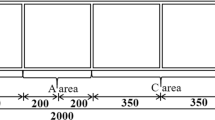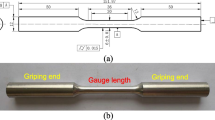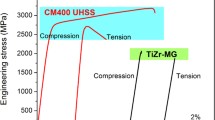Abstract
The general influence of constraint effects on reversed low-cycle fatigue performance was investigated. Constraint effects are being considered to have contributed to the failure of welded Steel Moment Resisting Frames (SMRFs), were cracks initiated in constraint regions during recent earthquakes. However, this study revealed that high constraint enhanced the resistance to crack initiation during cyclic loading by reducing the local strains at the notch tip. Furthermore, changes in toughness due to various constraint severities had almost no influence on the low cyclic performance of steel under constraint. This applies to low and high stress levels as well as low and high constraint, covering the whole range of possible scenarios of low-cycle and even towards high-cycle fatigue. While high toughness is still important for enhancing the fracture strength to accommodate the maximum imposed stresses/strains in earthquake loading, it most likely does not play a key role in cyclic performance.








Similar content being viewed by others
References
Campell HH III (1995) The Northridge fractures: are we learning the right lessons? Civ Eng 65:62
Hamburger RO (1998) An overview of seismic performance issues for moment-resisting steel frame buildings in the United States. Summary report of third US-Japan workshop on steel fracture issues, Japan, p 193
Miller DK (1998) Lessons learned from the Northridge earthquake. Eng Struct 20:249
Zarghamee MS, Ojdrovic RP (1995) Northridge postscript: lessons on steel connections. Civ Eng 65:105
Tsai KC, Popov EP (1997) Seismic steel beam-column connections, steel moment frame structures: background reports, FEMA-288, SAC 95/09, p 4
Drescher-Krasicka E, Ostertag CP (1999) Residual stress measurements in welded steel beam column connections by scanning acoustic microscopy. J Mat Sci 34:4173
Kuwamura H (1997) Transition between fatigue and ductile fracture in steel. J Struct Eng 123:864
Kuwamura H, Yamamoto K (1997) Ductile crack as trigger of brittle fracture in steel. J Struct Eng 123:729
Rosien FJ, Ostertag CP (2003) Low cycle fatigue behavior of constraint connections. Part II: influence of material parameters. Mater Struct (to be published)
Murakami Y (1987) Stress intensity factors handbook, Committee on fracture mechanics, The Society of Material Science of Japan, Pergamond Book Inc., Elmsford, NY
Ewing DJF, Hill R (1967) The plastic constraint of V-notched tension bars. J Mech Phys Solids 15:115
Acknowledgments
Funding for this research was provided by the National Science Foundation Grant Nr. CMS-9821043. The authors would like to thank Professor R. O. Ritchie in the Materials Science Department at the University of California, Berkeley and Dr. J. M. Barsom for many fruitful discussions.
Author information
Authors and Affiliations
Corresponding author
Rights and permissions
About this article
Cite this article
Rosien, F.J., Ostertag, C.P. Low cycle fatigue behavior of constraint connections. Mater Struct 42, 161–170 (2009). https://doi.org/10.1617/s11527-008-9375-9
Received:
Accepted:
Published:
Issue Date:
DOI: https://doi.org/10.1617/s11527-008-9375-9




